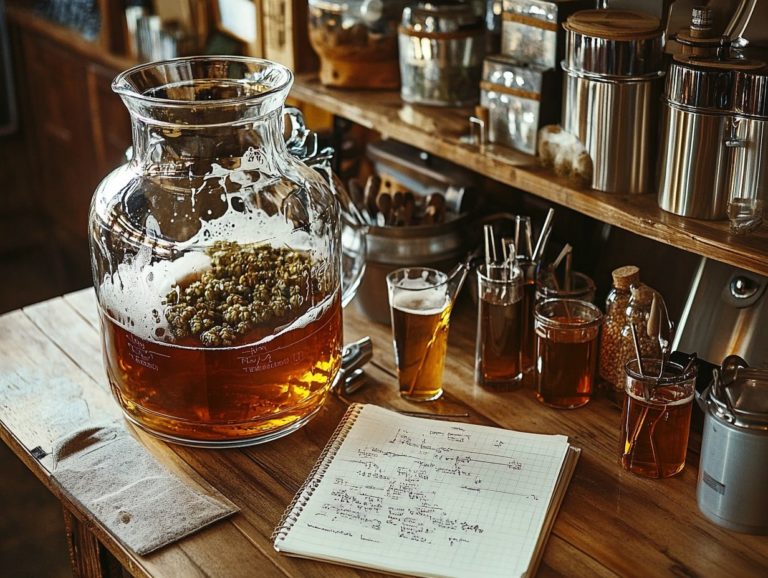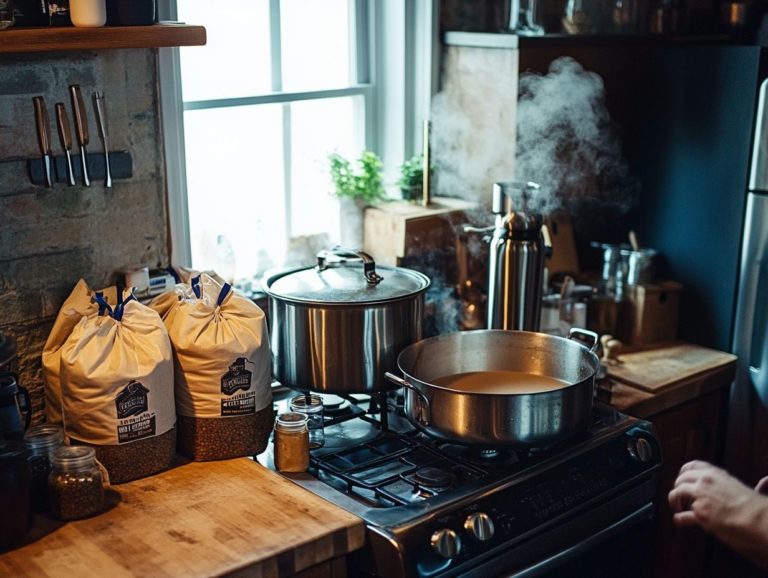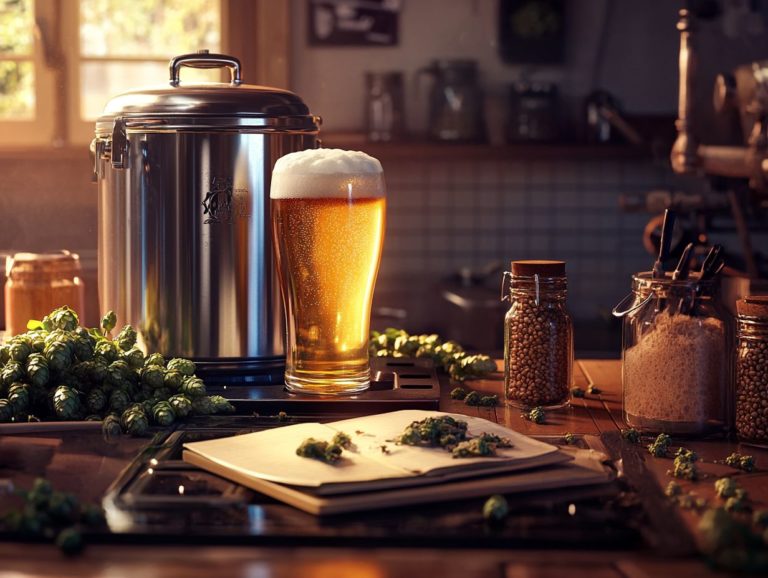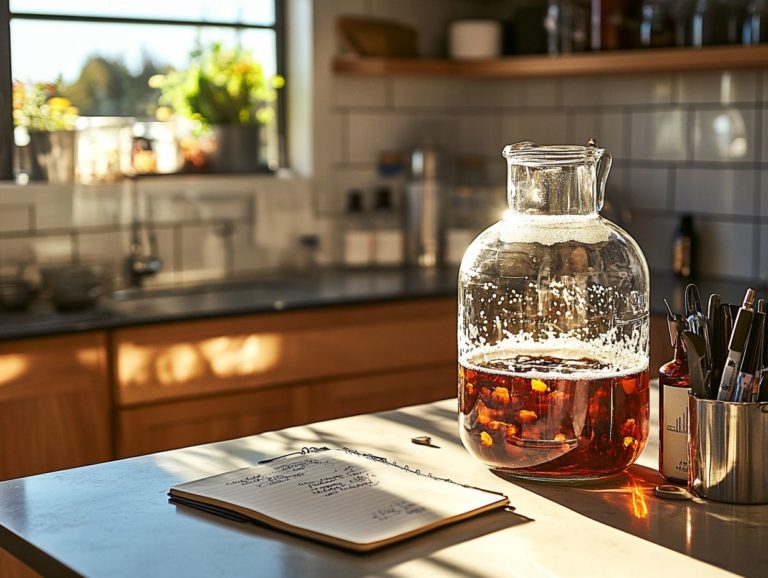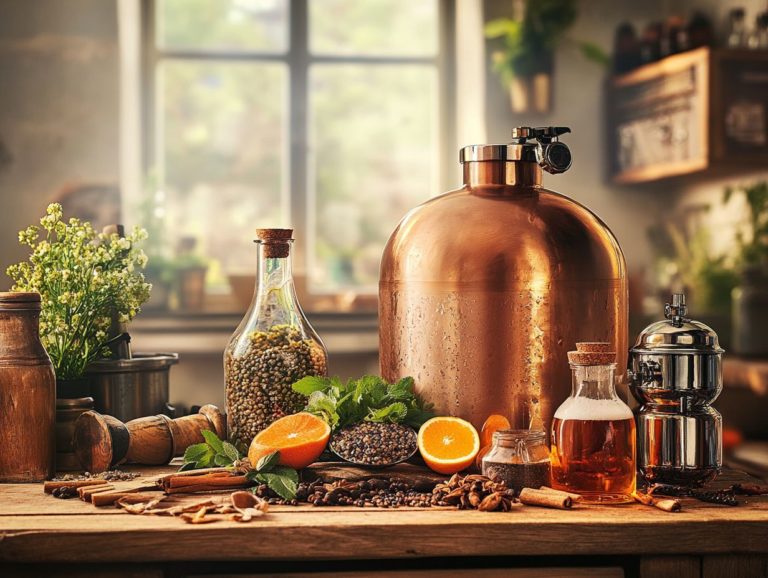How to Choose the Right Yeast for Brewing
Contents
- Introduction
- Key Takeaways:
- Types of Yeast for Brewing
- Factors to Consider When Choosing Yeast for Brewing
- Alcohol Tolerance
- How to Choose the Right Yeast Strain for Your Beer
- Experiment with Different Yeast Strains
- Storing and Handling Yeast for Brewing
- Yeast Starters
- Troubleshooting Common Yeast Problems
- Contamination
- FAQs
- What factors should I consider when choosing the right yeast for brewing?
- What is the difference between ale and lager yeast?
- How do I know which yeast strain will produce the desired flavors in my beer?
- Can I use the same yeast for different types of beer?
- What is the importance of fermentation temperature when choosing yeast?
- How do I know if the yeast I chose is suitable for the beer I want to brew?
- FAQs
Introduction
Choosing the right yeast, whether it’s dry yeast or liquid yeast, is essential for crafting exceptional beer, as it plays a pivotal role in fermentation and flavor development.
You ll find that different types of yeast are utilized in brewing, from classic ale and lager yeasts to intriguing wild and specialty strains. This includes notable strains like WLP001, WLP002, and WLP300.
As you embark on this brewing journey, consider essential factors such as fermentation temperature, flavor profiles, attenuation (the conversion of sugars to alcohol), flocculation (the clumping together of yeast cells), and alcohol tolerance.
Whether you re just starting out or you ve already honed your skills, a solid understanding of yeast and brewing techniques, such as pitching rate and brewing schedule, will undoubtedly elevate your brewing game.
Dive into the fascinating world of yeast selection, storage, and troubleshooting common issues like diacetyl and acetaldehyde to ensure that your homebrew stands out as truly remarkable.
Key Takeaways:
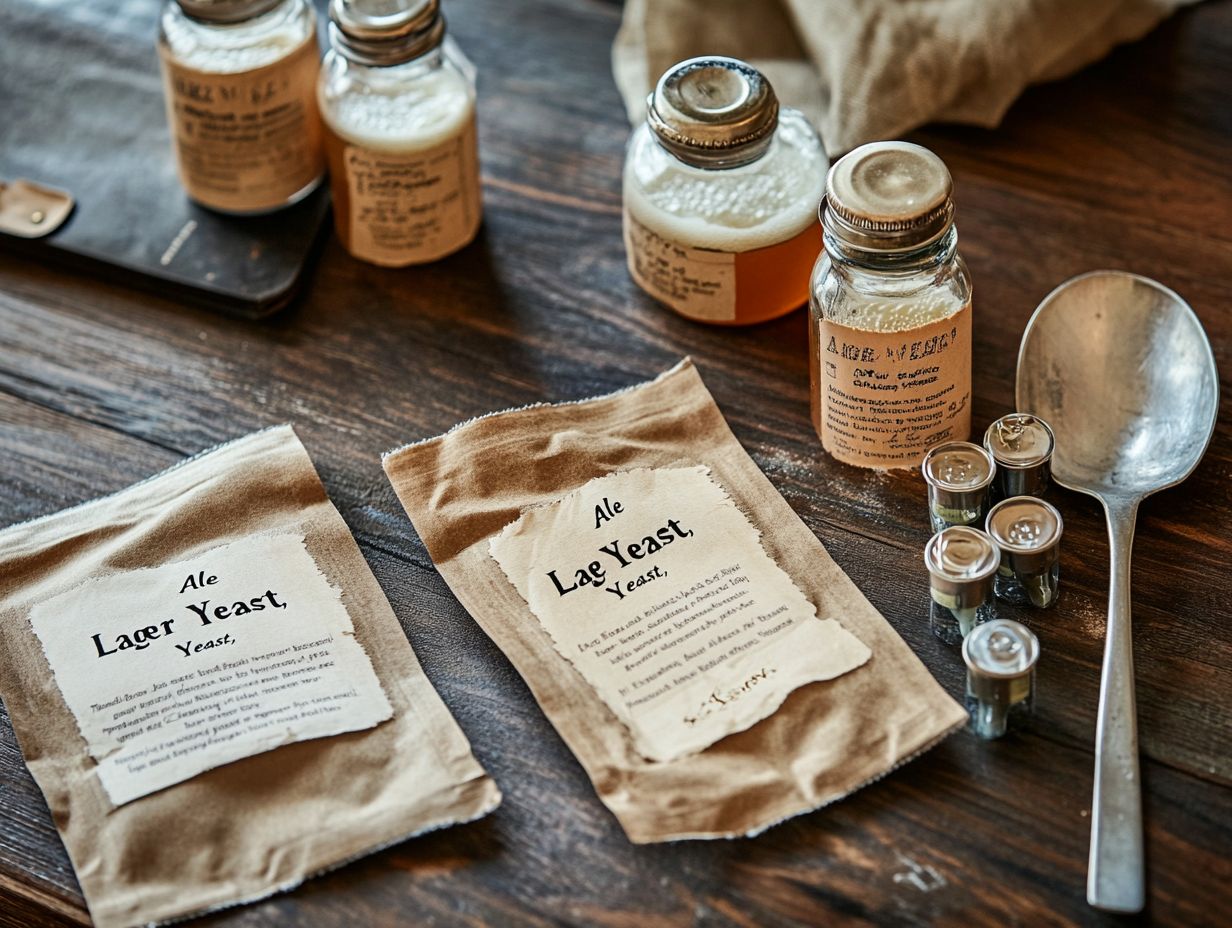
- Consider the style of beer you want to brew when choosing a yeast strain to ensure the desired flavor profile and yeast characteristics.
- Proper storage and sanitation of yeast are crucial for successful brewing.
- Experiment with different yeast strains to find the perfect fit for your beer.
Types of Yeast for Brewing
As you immerse yourself in the art of brewing, it s crucial to grasp the diverse types of yeast that can elevate your craft to new heights. Yeast is not just a key player in fermentation; it s an essential architect of the beer’s sensory profile and flavor compounds.
Various yeast strains, such as Saccharomyces cerevisiae and Saccharomyces pastorianus, impart distinct flavor profiles think fruity esters dancing in ales versus the crisp, clean characteristics of lagers.
Exploring wild and specialty yeast, including Belgian strains, can lead to delightful surprises, adding layers of complexity to your brews.
Thus, choosing the right yeast becomes a foundational aspect of your brewing journey.
Ale Yeast
Ale yeast, particularly Saccharomyces cerevisiae, is celebrated for its ability to flourish at warmer fermentation temperatures, leading to an array of flavor profiles rich in fruity esters and a pleasant mouthfeel (the way the beer feels in your mouth).
This distinctive trait enables fermentation to occur within the range of 60 F to 75 F (15 C to 24 C), significantly shaping the beer s taste and aroma. For example, Hefeweizen often bursts with notes of banana and clove.
Abbey Ales introduce you to a world of complex dark fruit flavors and delightful sweetness stemming from the yeast.
By employing certain brewing techniques like controlling fermentation temperature and managing oxygen levels you can enhance the production of these esters, resulting in a more vibrant fruity character.
By carefully manipulating the fermentation conditions, you can craft a stunning variety of ales, each one showcasing unique yeast-driven traits and overall complexity.
Lager Yeast
Lager yeast, specifically Saccharomyces pastorianus, thrives in cooler fermentation temperatures, allowing you to craft beers that boast a clean and crisp flavor profile, setting them apart from their ale counterparts.
By skillfully managing fermentation temperatures, typically ranging from 45 F to 55 F (7 C to 13 C), you can encourage this yeast to flourish while minimizing the production of esters and phenols, thus avoiding unwanted off-flavors, such as diacetyl and acetaldehyde.
This meticulous approach culminates in the signature clarity and refreshing taste that lager enthusiasts truly cherish.
Well-known styles like Pilsners, Helles, and M rzen highlight the impressive versatility of lager yeast, revealing subtle flavor nuances that reflect both your choice of ingredients and the brewing techniques you employ.
In the end, the dependable performance of lager yeast is essential for achieving the desired profile, ensuring that each brew meets the elevated standards expected by discerning beer lovers.
Wild Yeast
Wild yeast brings an exhilarating element of unpredictability to the fermentation process. It often results in complex flavor compounds that can elevate the uniqueness of your Craft Beer. These yeasts contribute to a rich tapestry of flavors, including carbonyls.
Unlike cultivated yeast strains, which are selectively bred for consistency and predictability, wild yeast flourishes in diverse environments. This unleashes a broad spectrum of flavors and aromas. These adventurous yeast strains can conjure up distinctive notes that range from fruity and floral to funky and earthy, creating a captivating sensory journey for you, the drinker.
However, managing fermentation with these unpredictable microorganisms can pose a challenge for brewers. They must diligently monitor temperature, oxygen levels, and various other variables to guide the yeast’s behavior. This intricate dance balances the raw potential of wild yeasts with the brewer’s vision, ultimately resulting in innovative and memorable brews that leave a lasting impression.
Specialty Yeast
Specialty yeast strains empower you as a brewer to craft unique beers that possess distinct characteristics unattainable with standard yeast varieties. They are essential for innovative craft beer production.
Among these, Belgian yeast strains truly shine. They are celebrated for their intricate profiles that elevate the flavor, aroma, and overall mouthfeel of your creations. These strains are well-suited for unique brewing water profiles that enhance their distinct characteristics. They produce a variety of flavors and aromas, giving rise to the fruity and spicy notes that define Belgian beer styles. As you experiment with these strains, you will be thrilled to uncover an exciting array of flavors, leading to distinctive brews that each tell a compelling story.
This versatility enables you to push the boundaries of traditional brewing while captivating adventurous beer drinkers in search of novel experiences.
Factors to Consider When Choosing Yeast for Brewing
Choosing the right yeast is essential for brewing. It requires careful consideration of key factors like your brewing equipment and methods.
You need to think about fermentation temperature, the flavor profile you aim to achieve, attenuation rates, flocculation characteristics, and alcohol tolerance. Each of these elements can significantly impact the final product, shaping the unique character and quality of your brew. Understanding your brewing schedule and wort sugars will optimize your process.
Fermentation Temperature
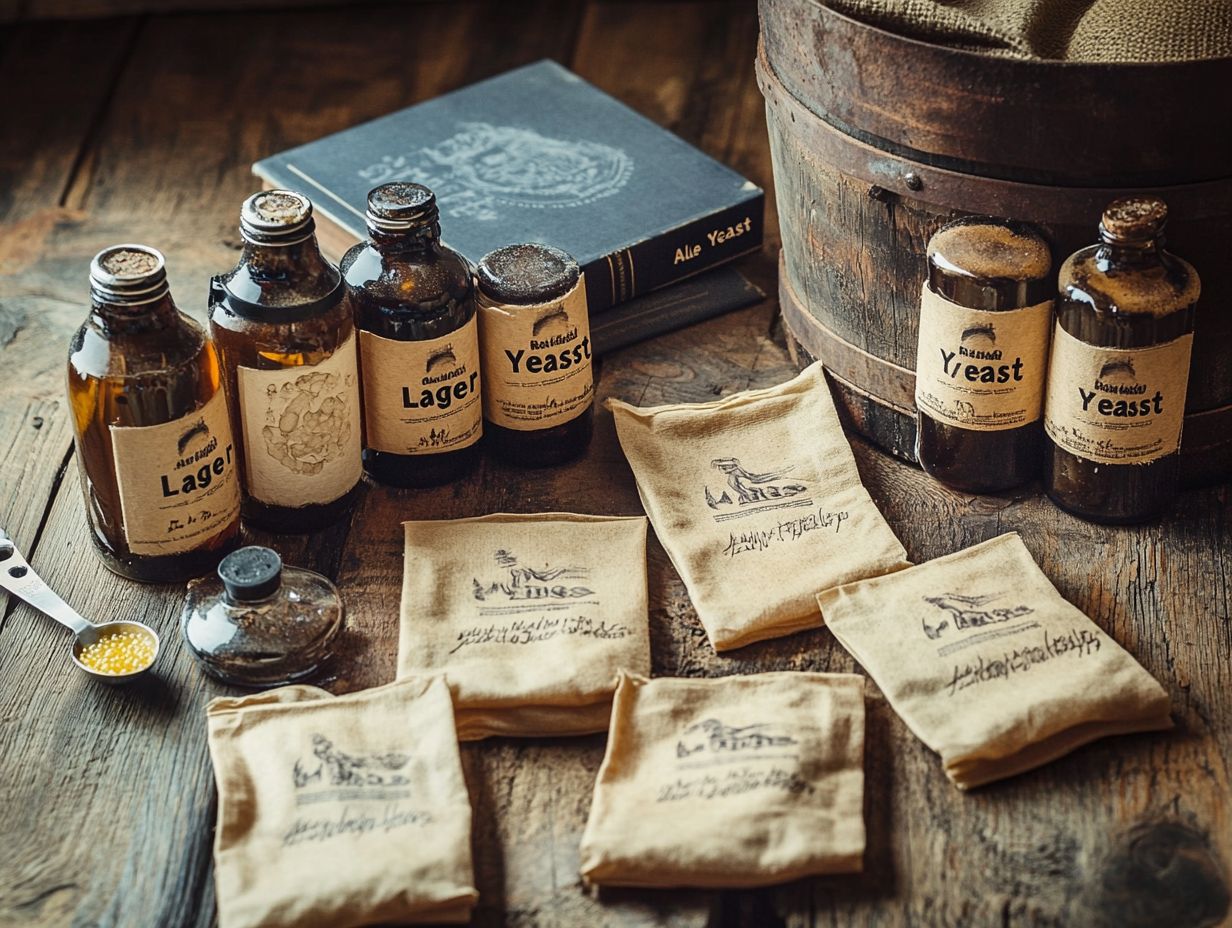
The fermentation temperature is a pivotal element in brewing. It significantly influences yeast activity and shapes the overall flavor profile of your beer, setting the stage for the entire fermentation process. This is what sets ale brewing apart from lager brewing, each with its ideal temperature ranges.
For ales, yeast flourishes in warmer environments, typically between 65 F and 75 F. This warmth fosters the production of fruity esters and phenolic compounds, elevating the beer’s complexity and character. On the other hand, lagers thrive at cooler fermentation temperatures, generally between 45 F and 55 F. This results in a clean, crisp finish with a subtlety that minimizes fruity notes.
When you carefully monitor and manage these temperature ranges, you enhance fermentation efficiency and boost the alcohol tolerance of the yeast. This allows for a more robust flavor profile that resonates with consumers. By grasping the specific requirements of different yeast strains, you can craft unique and delightful beverages that beautifully highlight the characteristics of both ales and lagers.
Flavor Profile
The flavor profile of your beer is significantly shaped by the yeast you choose for fermentation. Different yeast strains generate a variety of esters (fruity aromas) and phenolics (spicy or smoky flavors), all of which contribute to the beer s unique character.
Consider how selecting a particular yeast strain can introduce delightful fruity and floral notes, especially in styles like Belgian ales. The Belgian yeast is renowned for its ability to impart distinct esters such as banana and clove. These yeasts thrive in specific temperature ranges, enhancing their unique profiles.
Conversely, American ale yeast tends to produce cleaner, more subtle flavors, making it the perfect choice for styles like pale ales that demand a harmonious balance.
Specific brewing techniques can enhance these flavors even further. For instance, carefully controlling the fermentation temperature or extending the conditioning period allows you, as a brewer, to fine-tune the aromatic and flavor characteristics of your beers. By gaining a deep understanding of these yeast traits and how to manipulate them, you can create truly unique beverages that captivate the palate!
Attenuation
Attenuation is a vital component of fermentation. It represents your yeast’s capability to transform wort sugars into alcohol and carbon dioxide. This process directly influences the final flavor profile and mouthfeel of your beer. Effective yeast management and understanding attenuation can prevent off-flavors, such as diacetyl and acetaldehyde.
The degree of attenuation can vary significantly among different yeast strains. Some strains demonstrate high attenuation, fully fermenting most sugars, while others retain a sweeter, richer character due to lower attenuation. This variability is crucial for you as a brewer. Understanding how specific strains behave can help you achieve the perfect balance of sweetness and dryness in your finished product.
By selecting yeast that aligns with your flavor vision, you can create distinctive taste experiences. You can control residual sugar levels, which impacts body, carbonation, and overall drinkability. Mastering attenuation gives you the power to craft beers that resonate with your consumers, elevating both complexity and satisfaction in every sip, while also perfecting your fermentation techniques.
Flocculation
Flocculation refers to the remarkable ability of yeast to clump together and settle at the bottom of the fermenter. This crucial process helps achieve clarity in your final beer. You’ll find that this ability can vary significantly among different yeast strains.
This process is vital not only for enhancing the visual allure of the beer but also for ensuring a clean and efficient fermentation process. When yeast flocculation is on point, it enables the yeast to settle quickly after fermentation. This minimizes the risk of off-flavors and preserves your intended taste profile.
What s fascinating is that different yeast strains display varying degrees of flocculation. This not only affects clarity but also shapes the overall character of your beer, including its sensory profile. You can optimize flocculation by maintaining consistent fermentation temperatures, timing your dry hopping just right, and selecting yeast strains that align perfectly with the beer style you aim to create.
By focusing on these best practices, you can effectively manage the flocculation process. This ensures a superior final product that meets your brewing aspirations.
Alcohol Tolerance
Alcohol tolerance refers to how much alcohol yeast can handle during fermentation. It varies significantly among different yeast strains. This factor plays a pivotal role in the brewing techniques you employ for various beer styles, whether you’re brewing an ale, lager, or a specialty beer.
Understanding this concept is essential if you’re aiming to craft beers with higher alcohol content. Pushing a yeast strain beyond its tolerance limit can lead to incomplete fermentation and unwanted flavors, such as off-flavors that can affect the quality of your beer. Each strain has its own unique traits, including its ability to convert wort sugars into alcohol before succumbing to the toxic effects of its own production. Therefore, selecting the right yeast for your desired alcohol levels is crucial; it not only ensures successful fermentation but also influences the final flavor profile, aroma, and mouthfeel of your brew.
As a brewer, you often find yourself balancing the desire for a robust beverage with the performance capabilities of the yeast. Achieving that perfect equilibrium is key to mastering your craft.
How to Choose the Right Yeast Strain for Your Beer
Choosing the perfect yeast strain is one of the most exciting steps in brewing! It s a crucial part of the brewing process, demanding thoughtful consideration and an openness to experiment with different yeast varieties.
Explore this journey today to craft the flavor profile you ve always dreamed of!
Research Different Yeast Strains
Researching different yeast strains is essential for you as a brewer, especially if you want to grasp the unique characteristics and fermentation behaviors each strain brings to your beer. With a wealth of resources available, you can significantly enhance your understanding.
Diving into brewing literature think textbooks, journals, and articles provides you with a solid foundation. Meanwhile, online databases offer a treasure trove of information on yeast characteristics.
Engaging with brewer forums allows you to tap into real-world insights and practical tips from peers with firsthand experience. By thoroughly exploring these resources, both aspiring and seasoned brewers can make informed choices that lead to more successful and flavorful beer batches, honing their skills in homebrewing.
Consider the Style of Beer You Want to Brew
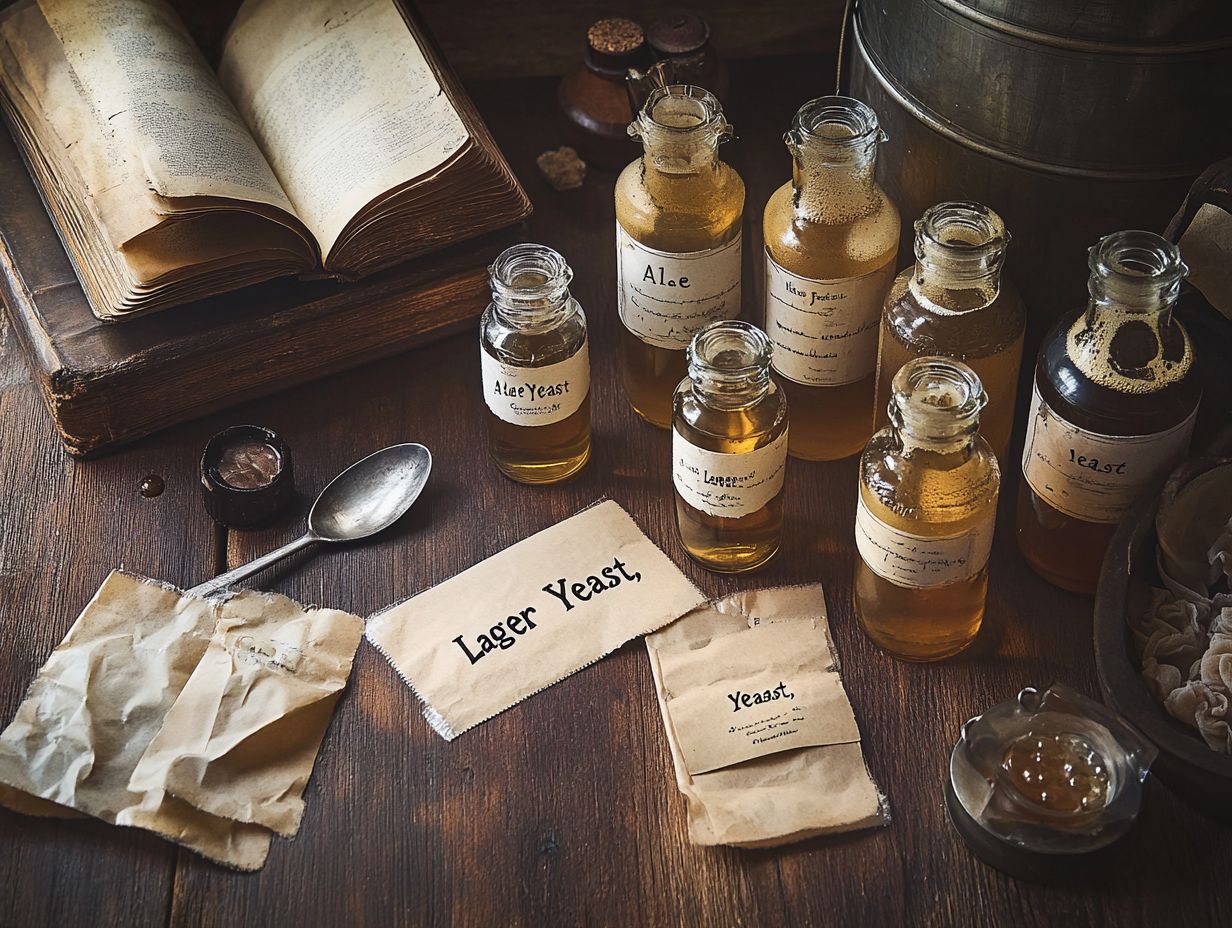
When selecting a yeast strain, considering the style of beer you wish to brew is crucial. Different beer styles require specific yeast characteristics to achieve the desired flavor profile and mouthfeel, whether it’s an ale yeast for ales or a lager yeast for lagers.
Ales usually thrive with top-fermenting yeast that enjoys warmer temperatures, often bringing along fruity esters and a hearty body. On the other hand, lagers excel with bottom-fermenting yeast, like Saccharomyces pastorianus, which requires cooler fermentation conditions and results in a clean, crisp taste.
Specialty beers add another layer of complexity, necessitating unique yeast strains that can impart distinctive flavors. Think about the delightful nuances in Belgian-style brews, such as Abbey Ale or Hefeweizen, or the tangy notes in sour ales. The relationship between your yeast selection and the beer style you are crafting shapes not just the aroma and flavor, but also affects clarity, carbonation, and overall drinkability.
This underscores the importance of thoughtful yeast consideration in your brewing journey.
Experiment with Different Yeast Strains
Ever wondered how different yeast strains can change your craft beer? Experimenting with various yeast strains can truly unlock a universe of possibilities for you as a Craft Beer brewer. This experimentation enables you to uncover new flavors and aromas that set your beers apart from the rest, whether you use dry yeast or liquid yeast.
By dedicating time to these experimental processes, you ll gain valuable lessons on how each yeast strain interacts with various ingredients and brewing techniques. It s essential to start with small-scale trials, perhaps using 1 to 5-gallon batches. This approach conserves resources and minimizes risk, making it easier for you to explore your creative potential.
Maintaining meticulous records of fermentation temperatures, specific gravity readings (measurements of sugar content), and sensory evaluations will further empower you to analyze the outcomes effectively. Over time, these documented experiments can lead to remarkable innovations, resulting in signature brews that embody the unique essence of the craft beer movement.
Storing and Handling Yeast for Brewing
Proper storage and handling of yeast are essential for ensuring its viability and performance throughout the brewing process, particularly in yeast management. Pay close attention now to refrigeration methods, sanitation techniques, and the use of yeast starters to achieve the best results in your brewing schedule.
Refrigeration vs Freezing
When it comes to storing yeast, refrigeration is typically the way to go, as it helps maintain yeast viability and minimizes the risk of damaging those precious yeast cells. This is particularly important for brewers who strive for consistency in their fermentation results. By refrigerating yeast, you keep it dormant, allowing it to maintain its effectiveness over time without compromising cell integrity, which is crucial for preserving yeast characteristics.
Freezing has its advantages, especially for long-term storage. If executed properly, freezing can preserve yeast for several months, making it a practical choice for brewers who don t use yeast on a regular basis. However, be cautious, as freezing can introduce ice crystals that may rupture those delicate cells, potentially diminishing fermentation activity.
For the best results, it s advisable to store yeast in airtight containers in the fridge and to freeze it only if it s specifically designed for that purpose. Always remember to rehydrate it gradually before use to ensure peak performance during fermentation.
Proper Sanitation Techniques
Implementing proper sanitation techniques is essential in brewing to prevent contamination, allowing yeast to thrive without interference from unwanted microorganisms. The significance of sanitation cannot be overstated; even the slightest trace of bacteria or wild yeast can lead to off-flavors and spoilage in your brew.
It all starts with a thorough cleaning of your brewing equipment think fermenters, hoses, and kegs using alkaline cleansers to eliminate any organic residues, ensuring your brewing water is free from contamination. Once everything is clean, move on to sanitization with appropriate chemical solutions like iodine or phosphoric acid to minimize microbial presence.
Handling yeast demands meticulous care. Storing it at the right temperatures in sterilized containers is crucial for preventing contamination, especially when using strains like Saccharomyces cerevisiae. Be mindful of common spoilage sources, such as inadequately cleaned tools and airborne microbes. It s vital to maintain a clean workspace and routinely seal any open vessels.
By adopting these techniques, you can significantly reduce the risk of contamination and craft exceptional, high-quality products.
Yeast Starters
Creating yeast starters is a powerful technique to enhance how healthy the yeast is before you pitch it into the wort. This ultimately leads to a more vigorous fermentation process and better control over fermentation temperature. This method guarantees a healthy yeast population and allows you to manage fermentation temperature and pressure more effectively.
To make a yeast starter, you only need a few simple ingredients: dry malt extract or liquid malt extract, water, and, naturally, yeast. You’ll also require some essential equipment such as a sanitized jar or flask, a stirring spoon, and an airlock to maintain a controlled environment and ward off contamination, ensuring the best possible flavor compounds.
The process is straightforward: boil some water with the extract, cool it down, and then introduce the yeast. This initial fermentation phase is crucial as it helps the yeast acclimatize, which is particularly important for brewing high-alcohol beers or reviving older yeast strains.
With healthier yeast at your disposal, you can look forward to more consistent and efficient fermentation in your brewing endeavors!
Troubleshooting Common Yeast Problems
Troubleshooting common yeast problems is an invaluable skill for you as a brewer. Issues like off-flavors, slow or stuck fermentation, and contamination can severely compromise the quality of your final product.
Mastering this aspect of brewing ensures that every batch you create meets your high standards and delivers the exceptional experience you aim for!
Off-flavors
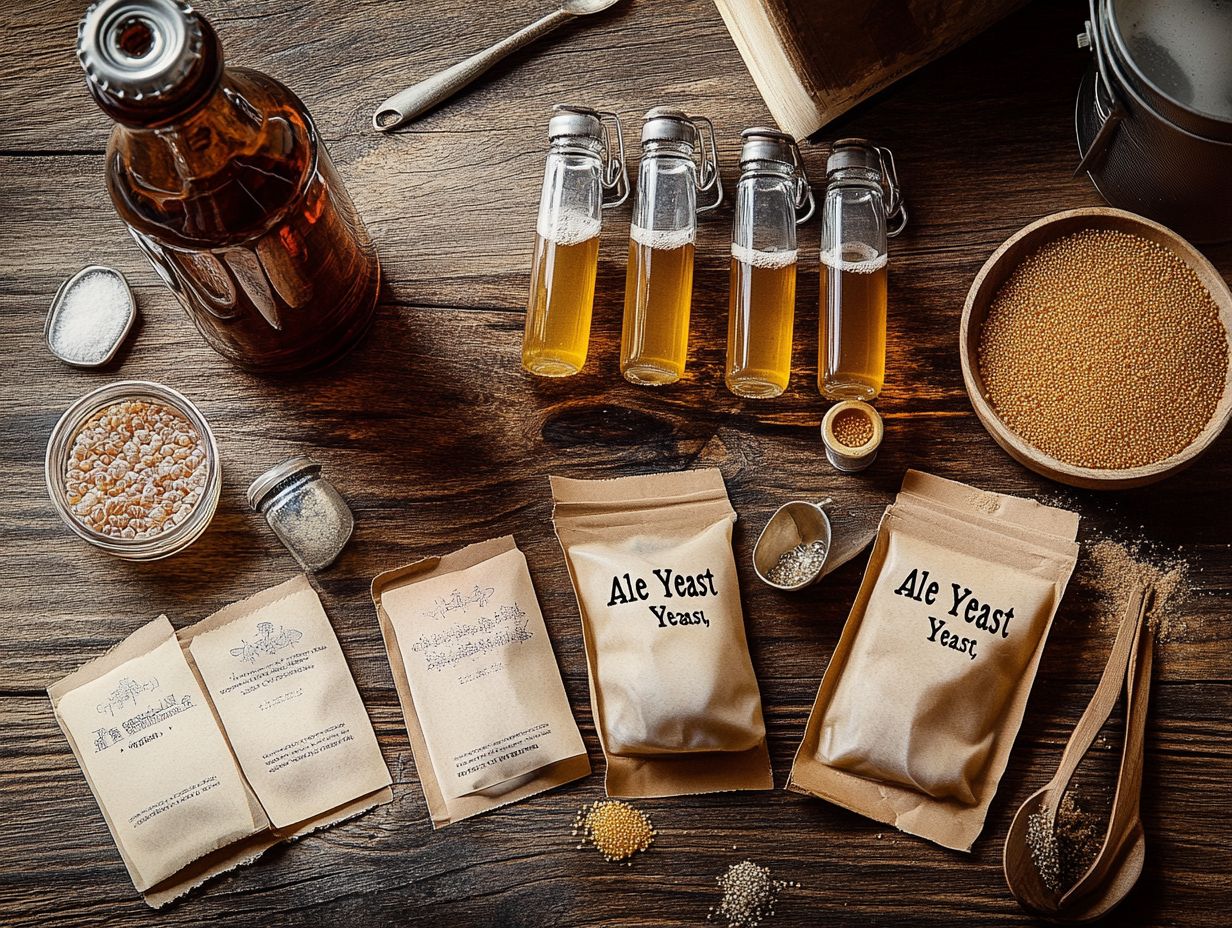
Off-flavors in your beer, like diacetyl and acetaldehyde, can emerge from yeast stress or improper fermentation conditions, leading to traits that compromise the brew’s overall quality.
When your yeast faces stress from temperature swings, nutrient shortages, or unwanted oxygen exposure, it starts to produce byproducts that can ruin the flavor and aroma of your creation. If you’re under-pitching your yeast, these issues may worsen because a struggling yeast culture has a harder time finishing fermentation effectively.
To keep those off-flavors at bay, it s crucial to maintain consistent fermentation temperatures and prioritize yeast health through proper nutrient management. Regularly monitoring fermentation progress, along with checking oxygen levels and yeast viability, will help you achieve a balanced fermentation process that elevates the desired flavor profile of your beer!
Slow or Stuck Fermentation
Slow or stuck fermentation can present significant challenges for you as a brewer. This often arises from issues like inadequate fermentation temperature or insufficient yeast viability, which can hinder the conversion of wort sugars.
These problematic conditions may result in undesirable flavors in your final product and diminish the overall efficiency of your brewing process. It s crucial to uphold optimal yeast health by ensuring proper pitching rates and sufficient oxygen levels during fermentation.
By diligently monitoring temperature fluctuations and maintaining the yeast’s preferred range, you can prevent delays and facilitate a smoother fermentation period. If complications do arise, assessing the yeast s activity and making necessary adjustments to the environmental factors can often revive the process, leading you to a successful batch!
Contamination
Contamination is a critical concern for brewers. It introduces unwanted microorganisms that can lead to off-flavors and spoilage.
This highlights the necessity of maintaining rigorous sanitation practices throughout the brewing process.
Various sources of contamination can emerge from equipment, ingredients, or even the air within your brewing environment. Wild yeast, bacteria, and foreign particles can threaten the integrity of yeast performance, ultimately affecting the flavor, aroma, and overall quality of your finished beer.
To mitigate these risks, you should implement a detailed cleaning plan that includes the regular cleaning and sanitizing of all brewing tools, fermenters, and storage vessels. You should use effective techniques like hot water rinses, chemical sanitizers, and air filtration systems to significantly lower the chances of contamination.
By keeping your brewing area spotless and consistently monitoring your equipment for any signs of contamination, you ensure that your batches remain safeguarded, allowing you to deliver a superior product to your consumers. Start implementing these practices today to brew the best beer possible!
FAQs
What factors should I consider when choosing the right yeast for brewing?
There are several factors to consider, including the type of beer you want to brew, the desired flavor profile, the fermentation temperature, and how well it ferments sugars and how it settles at the end of fermentation.
What is the difference between ale and lager yeast?
Ale yeast is generally used for top-fermenting beers and works best at warmer temperatures, while lager yeast is used for bottom-fermenting beers and requires colder temperatures for optimal performance.
How do I know which yeast strain will produce the desired flavors in my beer?
Each yeast strain has its unique characteristics and will produce different flavors and aromas in your beer. Research and experimentation are essential in finding the right yeast for your desired flavor profile.
Can I use the same yeast for different types of beer?
Yes, you can use the same yeast for different styles of beer, but it may produce varying results. It’s best to use a yeast strain that is recommended for the specific style of beer you are brewing.
What is the importance of fermentation temperature when choosing yeast?
Fermentation temperature plays a crucial role in the performance of yeast and the flavors it produces. Different yeast strains have different temperature ranges, so it’s essential to choose one that can thrive in the temperature range you can provide.
How do I know if the yeast I chose is suitable for the beer I want to brew?
Research and experimentation are crucial in determining the suitable yeast for your beer. Look for recommendations from experienced brewers or consult with your local homebrew shop for guidance on selecting the right yeast for your specific beer style.

